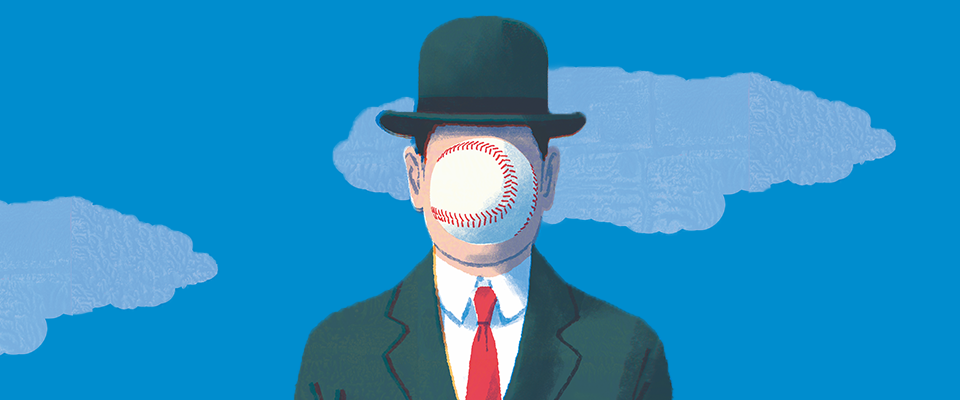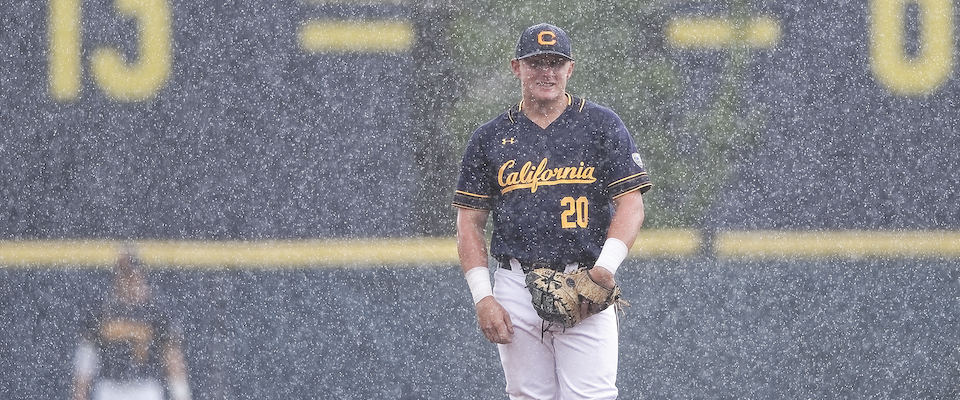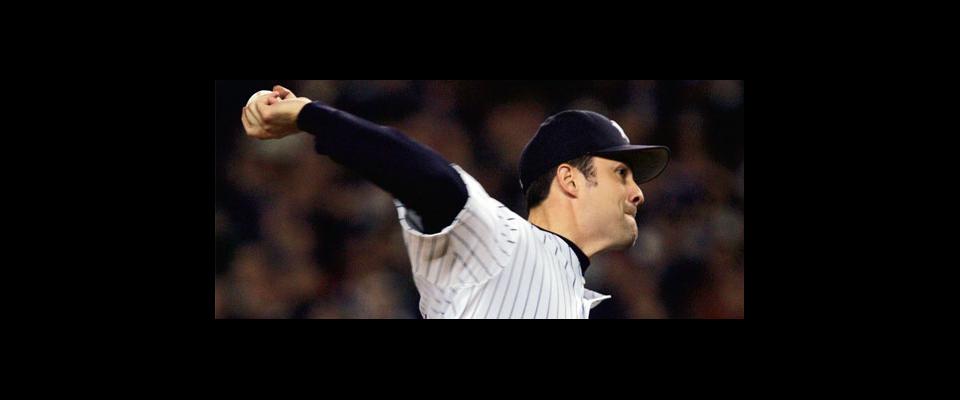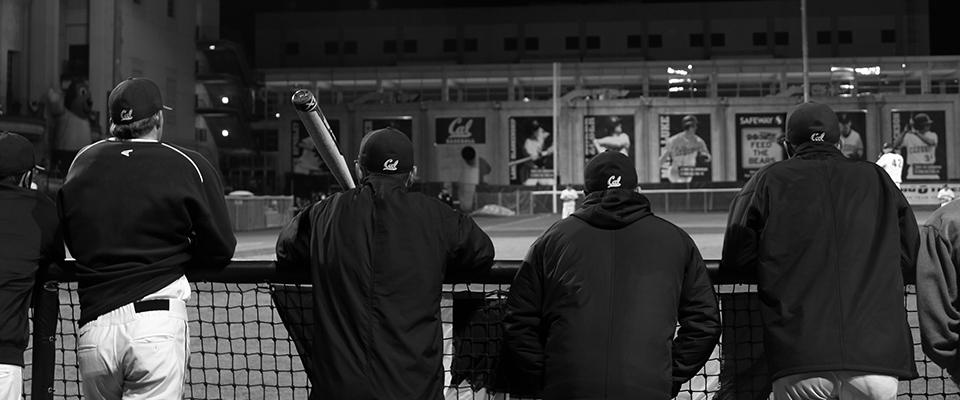How to watch baseball like a philosopher
I arrive at Evans Diamond on a chilly Friday night, find a bleacher seat among the 400-plus fans in attendance, put my phone on airplane mode, and pull out my scorebook. This is not my usual ballpark routine, but tonight I’m determined to watch this game through new eyes—or at least, through the eyes of UC Berkeley philosophy professor Alva Noë. I’ve just read his new book, Infinite Baseball: Notes from a Philosopher at the Ballpark, and have familiarized myself with his particular, even peculiar, way of understanding the game.
Much of Infinite Baseball is about the fan, specifically how to foster a more deeply engaged appreciation for the game. Step one: Get yourself to the stadium.
Familiar elements of the sport often sound unfamiliar in Noë’s telling. The strike zone becomes a “zone of responsibility,” and an at-bat is “an epic opportunity for self actualization.” As for baseball itself, “it is a domain of play; it is a field of thought; it is … a practice.”
“To play baseball is not just to run, catch, hit, and throw. It is to live in the baseball world. To play baseball you must care about baseball, have a stake in it, think about it.” The serious baseball spectator, he believes, would do well to follow suit.
Raised in New York City, Noë became a Mets fan at a young age, spending long nights under the covers, listening to games on a transistor radio. These days, he rarely misses a chance to watch the Mets play. Much of his academic work has focused on the intersection of philosophy and neuroscience, and more recently the role of art in our lives and how it connects to our nature as “conscious perceivers.” Infinite Baseball is a bit of a departure. A collection of short essays, most published between 2010 and 2017 on a now-defunct NPR science and culture blog, the book turns Noë’s philosophical lens on his early and enduring love for the sport. In addition to explorations of what baseball is and what it means, Noë discusses modern developments like instant replay, performance-enhancing drugs, and the increasing reliance on statistical analysis. Much of Infinite Baseball is about the fan, specifically how to foster a more deeply engaged appreciation for the game. Step one: Get yourself to the stadium.
“When you watch a game on TV, someone else—the producers and commentators—does the work for you,” Noë writes. “They tell you what to pay attention to and what not to pay attention to. They digest the reality on the field for you. They deliver a story with a tidy script.”
Which is not unlike the task I’ve been assigned here. My job is to digest the reality of this opener of a three-game series against Cal’s Pac-12 rival, the Washington State Cougars, and deliver a tidy script in the form of an article. The original idea was to attend the game with Noë and discuss the action on the field through the prism of his book. As with many a well-laid plan, however, this one went awry. Noë was called away on a last-minute trip to New York (I have a sneaking suspicion he went to catch a Mets game). But if baseball teaches us anything, it’s how to bounce back from failure. So I show up to the stadium anyway, Infinite Baseball in hand, and cast what I hope is a philosophical gaze upon the proceedings on the field.
As the great baseball thinker Yogi Berra once said, “You can observe a lot by just watching.”
“The thing about baseball is that it doesn’t really reduce to the highlight reel,” Noë writes. “A baseball game is more like a movie. It’s got a whole narrative arc that unfolds.”
Despite a forecast calling for rain, we’re treated to dramatic gray-blue skies and a light breeze that buffets the Pac-12 pennants beyond the right-field wall. Evans Diamond is a no-frills ballpark, a setting Noë would surely approve of. Many of today’s major league parks, with their IMAX-sized scoreboards, elaborate outfield water features, and multistory shopping and dining complexes, are an affront to the professor’s sensibilities. Noë feels that the game alone should be entertainment enough. “The whole point of today’s stadiums seems to be toward urging people to get out of their seats,” he gripes. At Evans Diamond, there’s only one attraction on the playbill: baseball.
And high-quality baseball at that. Though the college game gets far less attention than its counterparts in basketball and football, it’s not due to a lower caliber of competition. Many former Cal players now play in the big leagues including Marcus Semien and Mark Canha of the A’s. The Pac-12 is a power conference, boasting the defending national champion, Oregon State, and top-ranked UCLA. And Cal has one of the best amateur players in the country in Andrew Vaughn, the fellow now swaggering up to the plate with one down in the bottom of the first. Vaughn’s walk-up song is “Hell of a Night,” a country tune celebrating an epic evening of partying, and his eye black is smeared down his cheeks like war paint. The Santa Rosa native has a penchant for launching balls onto the roof of the rec center beyond left field. Not this time, though. On a 1-1 count, he flies out to left.
A little anticlimactic, but not necessarily insignificant. “The thing about baseball is that it doesn’t really reduce to the highlight reel,” Noë writes. “A baseball game is more like a movie. It’s got a whole narrative arc that unfolds.”
Accordingly, I’m determined to train my eye on moments that might not appear on a SportsCenter recap, but which advance the plot nonetheless. As Vaughn jogs, scowling, back to the dugout, he removes his helmet to reveal hair dyed a splotchy pink. I think, character development.
The game commences at a brisk pace, with the starting pitchers for both squads shutting down the opposing batters. Speeding up games has become a preoccupation for the governing bodies of baseball at all levels. As a result, both the NCAA and Major League Baseball have instituted new rules this season aimed at accelerating the action. MLB has been the more aggressive of the two, calling for shortened time between innings, a three-batter minimum for pitchers, and a reduction in the number of visits coaches are allowed to make to the pitching mound per game. All of these changes betray a fundamental anxiety that baseball executives hold about their sport: that it’s too slow for today’s easily distracted audiences.
“Baseball is boring,” Noë told me cheerfully. “But it’s boring the way physics is boring or classical music is boring. If you don’t know what’s going on, it’s indeed mind-numbingly, excruciatingly boring.”
In one of the few effusive moments in Infinite Baseball, Noë writes, “I say, God save us from today’s ramped-up, multi-interrupted, selfie-consumed, fast-paced world! We need to slow down. We need to turn off. We need to unplug. We need to start things and not know when they are going to end. We need evenings at the ballpark, evenings spent outside of real time.”
Infinite Baseball gets its title in part from the fact that a ballgame, governed by innings rather than a clock, can theoretically last forever. “A baseball game, like a good conversation, or a friendship, or a political controversy, has no fixed end,” Noë writes. “It takes however long it takes.” The game advances at a leisurely pace, offering the spectator time to ruminate on the proceedings—or wonder what else might be on TV. A few weeks before the game I met with Noë in his office, and I asked him if he thought the well-worn critique, that baseball was boring, was justified.
“Baseball is boring,” he told me cheerfully. Noë has a kind face, a graying beard, and a soft voice that makes every statement sound like some pleasant reminiscence. “But it’s boring the way physics is boring or classical music is boring. If you don’t know what’s going on, it’s indeed mind-numbingly, excruciatingly boring. From a detached, dispassionate point of view, it basically just looks like a lot of guys standing around on the field scratching themselves—with occasional bursts of energy.”
Noë believes that the real game of baseball occurs in between those energy bursts. It happens in the form of defensive position changes; hand signals from the third base coach to the base runner; communication between second baseman and shortstop; even the batter’s scratching, grimacing, and adjusting his batting gloves while grappling with the all-important question: What is the pitcher going to throw next? This doesn’t happen between the action. It is the action.
“Once you have been brought into it, once you have been given the eyes to see, it’s actually a game of immense tactical complexity,” Noë said. “In fact, I find it’s hard to keep up with how much is happening at a given moment.”
Baseball, he seems to be saying, isn’t better than other sports, it’s just different—in a better kind of way.
Employing Noë’s read-between-the-action approach to spectating, I catch what feels like a notable plot point when, in the bottom of the second, Cal’s jaunty, bearded shortstop, Sam Wezniak, steps to the plate. He swings so hard at the first pitch that he momentarily loses his balance. At which point, the Cougars dugout erupts in whistles and derisive laughter. Swinging hard is, of course, part of the game, but according to baseball’s strange etiquette swinging overly hard can be considered impertinent and insulting.
There’s a whiff of tension in the air. Rising action, I think. My script may come together yet.
Noë is hardly the first person to subject baseball to intellectual inquiry. More ink has been spilled exploring the significance of the national pastime than on any other sport. Boxing would rank a distant second. My own unscientific survey of the stacks in Cal’s Doe Library revealed a ratio of six baseball books for every one about “America’s sport,” football.
Noë argues that baseball has inspired this profusion of writing because it is a “thinking game.” Which is not to say that baseball players are rocket scientists (or even philosophers). Rather, Noë asserts that playing baseball requires thinking a great deal about baseball. Fans of other sports would be right to bristle at this. Does playing basketball not require thinking a great deal about basketball? Perhaps anticipating such reactions Noë writes, “To suppose that there’s something about [baseball] itself that makes it especially worthy of thought and attention smacks of the sort of chauvinism that might lead someone to think that his homely cuisine, or mother tongue, is somehow, truly, superior.”
The professor is straddling a fine line here. Baseball, he seems to be saying, isn’t better than other sports, it’s just different—in a better kind of way.
But, hey, fine by me. Baseball is better than other sports. I say that because it’s my game. My dad started taking me to A’s games as soon as I could walk, and most evenings we played catch in the driveway. I played for years and once coached a Little League team. I shed tears on the field, at the stadium, and in front of the television.
Those keeping score at a game will likely bear other marks of diehard fanaticism, such as a well-worn cap covered in commemorative pins or an earpiece for the play-by-play.
For Noë and me, baseball is our mother tongue, our homely cuisine. “We find it easiest to give full expression to our thoughts and feelings in the language we grow up speaking,” he writes.
That Noë, a philosopher, views baseball as a game defined by thought should come as no surprise. But he takes this notion further. He argues that thought, whether it occurs on the field, in the stands, or on the page, is part of the game. He elevates the spectator, commentator, and writer from mere observers to active participants. And where the player on the field wields bat and glove, the deeply engaged participant wields the scorebook.
For the uninitiated, scorekeeping is the practice of recording the proceedings of a baseball game in a specialized notebook (although more and more people now do it on—you guessed it—smartphones). Balls and strikes, the sequence of a putout, whether a batter struck out swinging or looking, who’s on first, etc., are all logged in shorthand. Those keeping score at a game will likely bear other marks of diehard fanaticism, such as a well-worn cap covered in commemorative pins or an earpiece for the play-by-play.
“Scorekeeping is not just a matter of recording the game,” writes Noë. “It is, rather, a way of thinking about the game. The scorekeeper asks, What is happening? Is that an earned run? Did the runner reach first on a fielder’s choice, or did he get a hit? Is that a sacrifice, or was the runner bunting for a hit? In order to keep score, you need to make these kinds of evaluations and decisions. And in order to make these kinds of calls you need to be closely engaged with the game. You need to pay attention. You need to understand what is going on. You need to have skill. You need to care.”
I’d scored portions of games before, mostly in Little League, but tonight I’m a bit rusty. It takes all my concentration to mark down the balls and strikes, the outcomes of each at-bat. Undeniably, scoring forces me to pay close attention to the action. If I do this right, at game’s end I will have in my hands a record, down to the smallest detail, of everything that transpired on the diamond. When Cal second baseman Darren Baker steps to the plate in the bottom of the sixth, I know that he struck out swinging in his first at-bat. As it happens, I also know that Baker is the son of famed Giants manager Dusty Baker, and that Dusty is sitting just a few rows behind me. There is no place to mark this detail in my scorebook.
A musical score is forward looking; it is a tool for making music. A baseball score is backward looking; it is a tool for making sense of what is already under way.
Four-and-a-half innings in, I’m thrown a curveball. Cal’s Conner Bock chops a high-bouncing grounder to the shortstop and hustles down the line. Though any fool can see he beat the throw by half a step, the umpire calls him out. If the decision miffs Bock, he doesn’t show it. The rangy, fresh-faced infielder stands beyond first base for a moment, a far-off look in his eyes, before turning and walking slowly back to the dugout. How, I wonder, should I mark it down?
A deep question, it turns out.
In chapter 14 of Infinite Baseball, “Nobody’s Perfect,” Noë defines two distinct theories about umpiring that he calls Realism and Anti-Realism. The first holds that balls, strikes, and outs are objective facts, and umpires are merely instruments to help ascertain what’s what. In this view, Bock should have been called safe. The ump made a bad call. But in the Anti-Realist view, a pitch is not a strike nor is a tag an out until the umpire deems it so. Balls, strikes, and outs simply don’t exist outside of the umpire’s reckoning. From this standpoint, calls are not good or bad—they just are. Writing that “Realism and Anti-Realism are extremist views,” Noë clarifies that he prefers something he calls Internal Realism, which I will oversimplify as being a blend of the two. In the serene acceptance of his fate, Bock seems to be an Anti-Realist, or at least the victim of one; he’s out because the ump said so.
I fall in line, marking the at-bat a “6–3”—a shortstop-to-first baseman putout.
“Baseball is distinctly engaged in the problem of telling its own story, with finding the right way to write itself down,” Noë writes. “A musical score is forward looking; it is a tool for making music. A baseball score is backward looking; it is a tool for making sense of what is already under way.”
Two innings later, I encounter a different sort of scorekeeping challenge. Bears left fielder Connor Mack is at the plate with a man on second. He’s down in the count, no balls and two strikes. Cougar pitcher Trevor Ichimura winds up and throws … and I don’t know what happens next. Somehow, I entirely miss how Mack’s at-bat plays out, leaving a gaping plot hole in my record.
Noë claims that baseball is fundamentally a forensic sport. I balked when I first read this. I pictured an umpire dusting a baseball for fingerprints. But he’s on to something.
Not only that, but it’s becoming increasingly clear that I mistranscribed several of the players’ names at the outset of the game. The PA system at Evans Diamond is decent, but I’m nonetheless having trouble distinguishing between the Kodies, Koreys, and Collins on both squads. The fact that there are two Connors and a Conner on the Cal team (as well as one of the former on the Cougars) feels like something that should be reported to the Department of Statistics. Remember Conner Bock, who so graciously yielded to the umpire’s judgment? Well, I’m fairly certain that was Connor Mack.
My errors are especially problematic in light of one of the more novel proclamations in Noë’s book: that baseball is fundamentally a forensic sport. That is, at its core it is about assigning credit and blame for events on the field.
I balked when I first read this. Forensic? I pictured an umpire dusting a baseball for fingerprints. But he’s on to something.
Baseball is most definitely a numbers game. Ever since the “father of baseball,” Henry Chadwick, invented the box score in 1859, statistics have been kept about players’ performance, from earned run average to on-base percentage to batting average. As Michael Lewis explored in his book Moneyball, these numbers—and what they mean about a player’s value—are an obsession among owners, coaches, and general managers. Underlying those statistics, Noë contends, is a preoccupation with assigning credit or blame. It is called an earned run average because runs that are scored due to defensive errors aren’t held against the pitcher. Similarly, if a batter reaches base because a fielder elected to get a different runner out (a fielder’s choice), the batter is not deemed to have earned safe passage to first base. (He’s not “out” on the field, but he is when calculating his batting average.) As Noë puts it, “we’re not so much interested in what happened as we’re interested in whodunit.”
Whodunit is a tough one when you can’t keep your Connors straight.
The languid pace of baseball invites the spectator to ponder each play. Your thoughts are not just part of the game but integral to it.
After five-and-a-half innings, the score is tied 0–0, a circumstance that doesn’t necessarily lend itself to dramatic storytelling for anyone but lovers of pitchers’ duels (which it should be noted, Noë is). But even a lackluster tale needs a climax, so here it is: After Cal scores a run in the bottom of the sixth, and then another in the bottom of the seventh, John Lagattuta, a left-handed batter, is brought in to pinch-hit for designated hitter Garret Nielsen, a righty. Lagattuta hasn’t played all that much this season, with only one hit in 15 at-bats, but on a 1–2 pitch he laces a line drive that bounces to the right-field wall. Two runs score, and the sophomore ends up at second with a double. Lagattuta was granted an epic opportunity for self-actualization, and he jumped all over it, likely putting the game out of reach for WSU. Baseball may be a thinking game, a philosophical game, a forensic game, and a numbers game, but it’s also a game of unlikely heroes.
Later on, Cal tacks on two more runs, making the final score 6–0.
One of the strengths of Infinite Baseball is that Noë’s views are so often surprising. At first blush, he comes off as a baseball traditionalist, promoting simple stadiums and the dying art of scorekeeping. But then he throws a few knuckleballs, weighing in favorably on the increasing use of instant replay, for example, and controversially defending the use of performance-enhancing drugs.
While I don’t agree with—or even understand—all of Noë’s views on the game, I’m most taken by his thoughts on deep engagement. I can’t count the times I’ve been told by detractors that baseball is boring and thought to myself, “You just don’t get it.”
“Boredom is the fruit of your disconnect, your disengagement,” writes Noë. I agree. We live in a time when, at the first hint of boredom, we instinctively reach for our phones. He wants you to sit with that boredom, to give your mind a chance to fill the void with thought. The languid pace of baseball invites the spectator to ponder each play. Your thoughts, he insists, are not just part of the game but integral to it.
“Take away the reflection,” Noë writes, “and you are left with mere activity—with something robots could do. And that’s not baseball.”
Maybe. Or maybe he’s overthinking it. Something to think about anyway.
Coby McDonald, M.J. ’17, is a frequent contributor to California. Illustration by Tatsuro Kiuchi.
From the Summer 2019 issue of California.





















